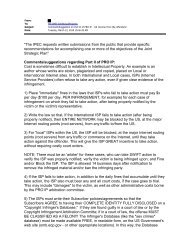We Energies Coal Combustion Products ... - The White House
We Energies Coal Combustion Products ... - The White House
We Energies Coal Combustion Products ... - The White House
Create successful ePaper yourself
Turn your PDF publications into a flip-book with our unique Google optimized e-Paper software.
<strong>The</strong> level of shrinkage strains depends on several factors, including<br />
temperature, humidity, mixture proportions, type of aggregates, etc. Shrinkage<br />
strain in hardened concrete induces elastic tensile stress. Cracks appear in<br />
concrete when the induced tensile stress exceeds the tensile strength of the<br />
concrete. Creep may reduce the induced tensile stress to a certain extent, but<br />
the resultant stress can be large enough for cracking concrete.<br />
Using sufficient steel reinforcement has traditionally controlled cracking.<br />
However, using reinforcement does not solve this problem completely. By<br />
using reinforcement, fewer large cracks may be reduced to numerous invisible<br />
and immeasurable microcracks (23). Transverse cracks seen in bridge decks<br />
are typical examples. Cracking in concrete is the first step to deterioration, as<br />
it results in the migration of harmful ions into the interior of concrete and to<br />
the reinforcement.<br />
Several preventive and mitigating measures can be used to minimize the<br />
degradation of concrete due to corrosion of reinforcing steel. <strong>The</strong> use of fly<br />
ash as a partial replacement of cement is a cost-effective solution (inclusion of<br />
fly ash in a mixture provides the same workability at a lower water content<br />
and lower cement content both of which reduces the concrete shrinkage). In<br />
several states across the country, the Department of Transportation (DOT) has<br />
made it mandatory to include fly ash as an ingredient. <strong>The</strong> heat of hydration is<br />
substantially reduced when fly ash is used in concrete as a partial replacement<br />
to cement.<br />
Durability of concrete is very critical in most DOT applications, especially in<br />
regions subject to cold weather conditions. In such cases, the incorporation of<br />
fly ash in concrete is advantageous, even though the setting and hardening<br />
process may be slightly slower than ordinary Portland cement concrete.<br />
Fly ash has been used in concrete for several decades. Research work on<br />
short-term and long-term behavior of concrete containing fly ash has been<br />
conducted by several research agencies. However, the properties of fly ash<br />
vary with the specific coal burned as well as the process of coal preparation,<br />
firing and collection.<br />
Hence, <strong>We</strong> <strong>Energies</strong> has conducted research on the actual fly ash generated at<br />
its coal-fired plants. This research has been conducted with the aid of<br />
universities and research institutions in conjunction with concrete producers to<br />
develop mix designs that can be readily used for construction. Several<br />
parameters, both short-term and long-term, have been studied, and their<br />
performances evaluated to identify the suitability of the particular mixture<br />
design for a specific field application. One important point is the spherical<br />
shape of fly ash with its lubricating effect for pumping and the same<br />
workability with a lower water to cementitious materials ratio. Also, fly ash is<br />
finer than Portland cement and thus produces a denser concrete with lower<br />
permeability.<br />
53 <strong>We</strong> <strong>Energies</strong><br />
<strong>Coal</strong> <strong>Combustion</strong> <strong>Products</strong><br />
Utilization Handbook



